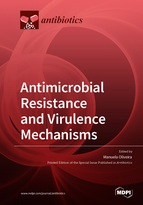Antimicrobial Resistance and Virulence Mechanisms
A special issue of Antibiotics (ISSN 2079-6382). This special issue belongs to the section "Mechanism and Evolution of Antibiotic Resistance".
Deadline for manuscript submissions: closed (28 February 2021) | Viewed by 38417
Special Issue Editor
Interests: antimicrobial resistance; bacterial virulence; biofilms; genomics; infections pathogenesis; food safety
Special Issues, Collections and Topics in MDPI journals
Special Issue Information
Dear Colleagues,
The emergence of antimicrobial-resistant bacteria, particularly those resistant to last-resource antibiotics, is now a common problem and has been defined as one of the three priorities for the safeguarding of One Health by the Tripartite Alliance, which includes the World Health Organization (WHO), the Food and Agriculture Organization (FAO), and the Office International des Epizooties (OIE). Bacterial resistance profiles, together with the expression of specific virulence markers, have a major influence on infectious disease outcomes. These bacterial traits are interconnected, since not only may the presence of antibiotics influence bacterial virulence gene expression and, consequently, infection pathogenesis, but some virulence factors may also contribute to an increased ability to resist bacteria, as observed in biofilm-producing strains. Surveillance of important resistant and virulent clones and associated mobile genetic elements is essential to decision-making in terms of mitigation measures to be applied for the prevention of such infections in both human and veterinary medicine. However, the role of natural environments as important components of the dissemination cycle of these strains has been disregarded until recently. This Special Issue aims to publish manuscripts that contribute to our understanding of the impact of bacterial antimicrobial resistance and virulence in the three areas of the One Health triad, i.e., animal, human, and environmental health.
Dr. Manuela Oliveira
Guest Editor
Manuscript Submission Information
Manuscripts should be submitted online at www.mdpi.com by registering and logging in to this website. Once you are registered, click here to go to the submission form. Manuscripts can be submitted until the deadline. All submissions that pass pre-check are peer-reviewed. Accepted papers will be published continuously in the journal (as soon as accepted) and will be listed together on the special issue website. Research articles, review articles as well as short communications are invited. For planned papers, a title and short abstract (about 100 words) can be sent to the Editorial Office for announcement on this website.
Submitted manuscripts should not have been published previously, nor be under consideration for publication elsewhere (except conference proceedings papers). All manuscripts are thoroughly refereed through a single-blind peer-review process. A guide for authors and other relevant information for submission of manuscripts is available on the Instructions for Authors page. Antibiotics is an international peer-reviewed open access monthly journal published by MDPI.
Please visit the Instructions for Authors page before submitting a manuscript. The Article Processing Charge (APC) for publication in this open access journal is 2900 CHF (Swiss Francs). Submitted papers should be well formatted and use good English. Authors may use MDPI's English editing service prior to publication or during author revisions.
Keywords
- antimicrobial resistance
- bacterial virulence
- biofilms
- epidemiology
- genomics
- infections pathogenesis
- One Health







